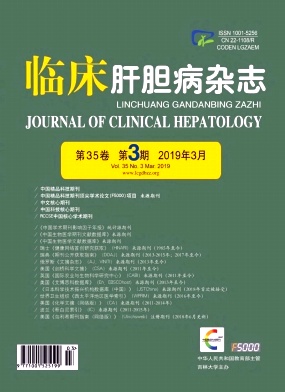|
[1] Drug-induced Liver Disease Study Group, Chinese Society ofHepatology, Chinese Medical Association. Guidelines for themanagement of drug-induced liver injury[J]. J Clin Hepatol, 2015, 31 (11) :1752-1769. (in Chinese) 中华医学会肝病学分会药物性肝病学组.药物性肝损伤诊治指南[J].临床肝胆病杂志, 2015, 31 (11) :1752-1769.
|
|
[2] GAN Y, DONG Y, ZHANG HF, et al. Clinical characteristicsand outcomes of drug-induced liver injury in children:Astudy of 184 cases[J]. J Clin Hepatol, 2015, 31 (8) :1244-1247. (in Chinese) 甘雨, 董漪, 张鸿飞, 等. 184例儿童药物性肝损伤的临床特征及转归状况评价[J].临床肝胆病杂志, 2015, 31 (8) :1244-1247.
|
|
[3] AMIN MD, HARPAVAT S, LEUNG DH, et al. Drug-inducedliver injury in children[J]. Curr Opin Pediatr, 2015, 27 (5) :625-633.
|
|
[4] FAA G, EKSTROM J, CASTAGNOLA M, et al. A developmen-tal approach to drug-induced liver injury in newborns andchildren[J]. Curr Med Chem, 2012, 19 (27) :4581-4594.
|
|
[5] ZHANG CP, MA Y. Analysis of 29 cases with drug-induced liverinjury in children[J]. J Pediatr Pharm, 2015, 21 (1) :44-47. (inChinese) 张长平, 马燕. 29例儿童药物性肝损伤临床分析[J].儿科药学杂志, 2015, 21 (1) :44-47.
|
|
[6] DU SX, LU LL, MIAO YX, et al. Features of children with drug-induced liver injury:An analysis of 34 cases[J]. J PracHepatol, 2016, 19 (5) :607-609. (in Chinese) 杜水仙, 卢琳琳, 苗英霞, 等.儿童药物性肝损伤34例分析[J].实用肝脏病杂志, 2016, 19 (5) :607-609.
|
|
[7] ZHU XX, WAN CM. Recent progress in management and treat-ment of drug-induced liver injury in children[J]. J Clin Hepa-tol, 2012, 28 (12) :896-898. (in Chinese) 朱欣欣, 万朝敏.儿童药物性肝损害[J].临床肝胆病杂志, 2012, 28 (12) :896-898.
|
|
[8] Branch of Hepatobiliary Diseases, China Association of Chi-nese Medicine, Branch of Chinese Patent Medicine, China As-sociation of Chinese Medicine. Guidelines for the clinical man-agement of herb-induced liver injury[J]. J Clin Hepatol, 2016, 32 (5) :835-843. (in Chinese) 中华中医药学会肝胆病分会, 中华中医药学会中成药分会.中草药相关肝损伤临床诊疗指南[J].临床肝胆病杂志, 2016, 32 (5) :835-843.
|
|
[9] WANG JB, MA ZJ, NIU M, et al. Evidence chain-basedcausality identification in herb-induced liver injury:Exemplifi-cation of a well-known liver-restorative herb Polygonum mul-tiflorum[J]. Front Med, 2015, 9 (4) :457-467.
|
|
[10] HE TT, ZHONG XW, ZHANG N, et al. Prospective clinicalstudy of 187 cases with liver damage caused by medicine andits preparations[J]. Chin Hepatol, 2018, 23 (8) :666-669. (in Chinese) 何婷婷, 钟学文, 张宁, 等. 187例中草药及其制剂导致肝损伤病例前瞻性临床研究[J].肝脏, 2018, 23 (8) :666-669.
|
|
[11] ZHU Y, LI YG, WANG JB, et al. Causes, features, and out-comes of drug-induced liver injury in 69 children from China[J]. Gut Liver, 2015, 9 (4) :525-533.
|
|
[12] CHALASANI N, FONTANA RJ, BONKOVSKY HL, et al. Cau-ses, clinical features, and out-comes from a prospectivestudy of drug-induced liver injury in the united states[J].Gastroenterology, 2008, 135 (6) :1924-1934.
|
|
[13] REN ZQ, WANG JH, GUO XY, et al. A review analysis of chi-nese literatures 2005-2014:Clinical features of drug-in-duced liver injury[J]. Chin J Pharmacoepidemiol, 2016, 25 (5) :284-289. (in Chinese) 任张青, 王进海, 郭晓燕, 等. 2005~2014年我国药物性肝损伤临床综合分析[J].药物流行病学杂志, 2016, 25 (5) :284-289.
|
|
[14] QI YB, QIU L, JIANG HL, et al. Clinical characteristics ofdrug-induced liver injury:An analysis of 394 cases[J]. JClin Hepatol, 2014, 30 (5) :438-441. (in Chinese) 祁亚宾, 邱玲, 姜红丽, 等.药物性肝损伤394例临床特点分析[J].临床肝胆病杂志, 2014, 30 (5) :438-441.
|
|
[15] YUAN L, YANG YG, SHEN YX, et al. Research advances indrug-induced liver injury[J]. J Clin Hepatol, 2017, 33 (2) :375-378. (in Chinese) 袁玲, 杨永耿, 沈有秀, 等.药物性肝损伤的研究进展[J].临床肝胆病杂志, 2017, 33 (2) :375-378.
|
|
[16] WANG L. Analysis of the disease composition and householdregistration of hospitalized children in Beijing[J]. Chin MedRecord, 2018, 19 (6) :35-37. (in Chinese) 王丽.北京市住院儿童疾病构成与户籍分析[J].中国病案, 2018, 19 (6) :35-37.
|
|
[17] SQUIRES RH Jr, SHNEIDER BL, BUCUVALAS J, et al. Acuteliver failure in children:The first 348 patients in the pediatric a-cute liver failure study group[J]. J Pediatr, 2006, 148 (5) :652-658.
|
|
[18] MURRAY KF, HADZIC N, WIRTH S, et al. Drug-related hep-atotoxicity and acute liver failure[J]. J Pediatr GastroenterolNutr, 2008, 47 (4) :395-405.
|
|
[19] ZHU Y, LIU SH, WANG JB, et al. Clinical analysis of drug-induced liver injury caused by Polygonum multiflorum and itspreparations[J]. Chin J Integr Tradl Western Med, 2015, 35 (12) :1442-1447. (in Chinese) 朱云, 刘树红, 王伽伯, 等.何首乌及其制剂导致药物性肝损伤的临床分析[J].中国中西医结合杂志, 2015, 35 (12) :1442-1447.
|
|
[20] HE TT, GONG M, BAI YF, et al. Clinical analysis of two diag-nosis methods for herb-induced liver injury[J]. China J ChinMater Med, 2016, 41 (16) :3096-3099. (in Chinese) 何婷婷, 宫嫚, 白云峰, 等. 2种药物性肝损伤诊断指南的应用分析[J].中国中药杂志, 2016, 41 (16) :3096-3099.
|







 DownLoad:
DownLoad: